Analyzing Technological Improvements in Travel and Tourism Sector
VerifiedAdded on 2024/05/31
|15
|3625
|235
Essay
AI Summary
This essay examines the significant improvements in the travel and tourism sector due to technological advancements. It discusses how technology enhances the global distribution system, improves marketing operations, and fosters better communication between businesses and consumers. The research questions address the alignment of technological growth with the development of the travel and tourism sector and the overall impact of technology on this industry. The objectives include evaluating the influences of technological advancement, exploring the impacts of technology consideration, and examining how technology aids tourism marketing in developing operational skills. The essay also addresses the problem of potential disruptions and cybercrime threats associated with technology, emphasizing the importance of effective marketing plans and customer satisfaction in a competitive market. It further delves into how tourists can now plan holidays independently using mobile technology, impacting sales and requiring agencies to adapt to changing consumer behaviors. The literature review highlights the importance of social networking and digital marketing in modern tourism, with a focus on online purchasing trends and customer reviews. The research methodology section outlines the data collection and analysis techniques, ethical considerations, and research limitations.
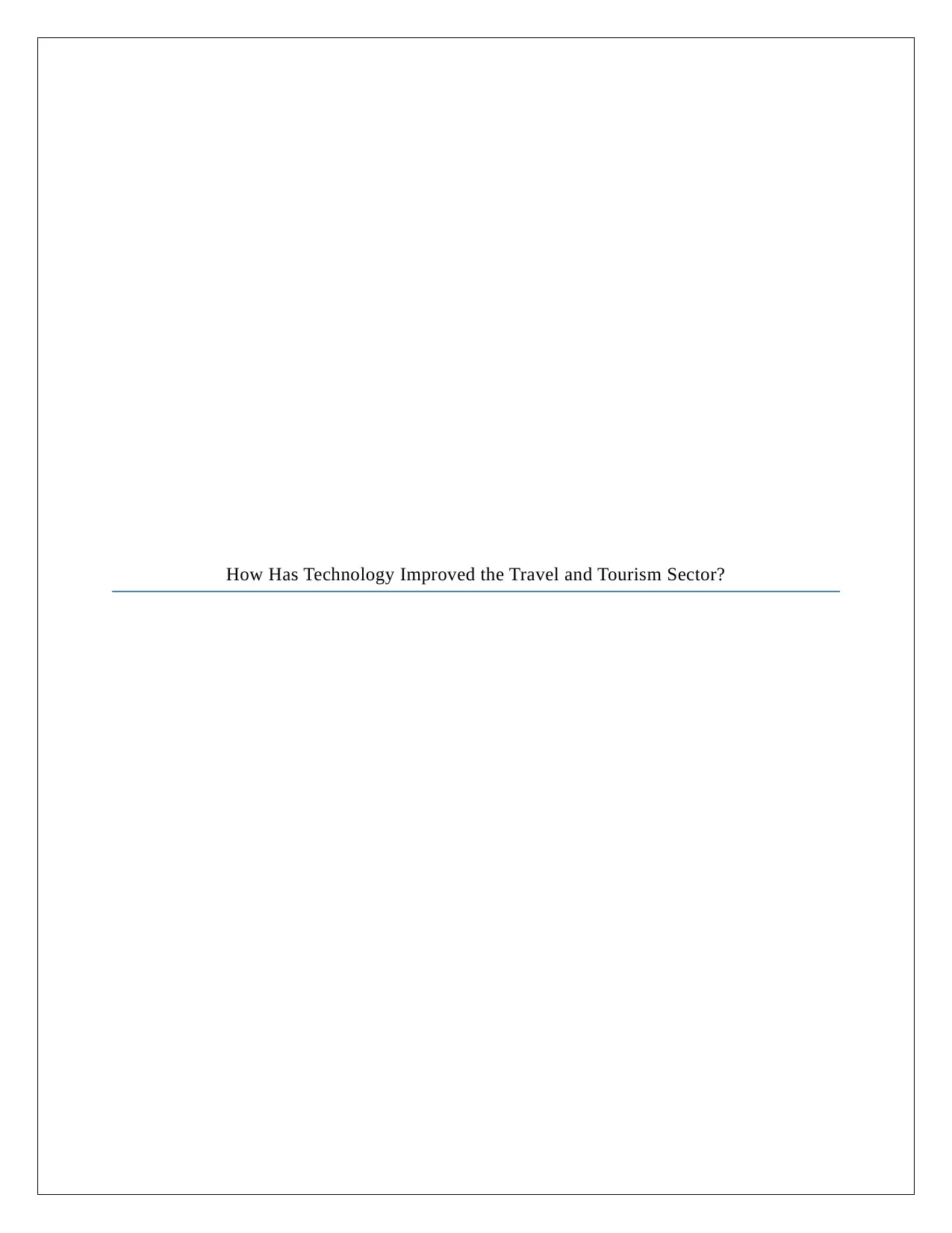
How Has Technology Improved the Travel and Tourism Sector?
Paraphrase This Document
Need a fresh take? Get an instant paraphrase of this document with our AI Paraphraser
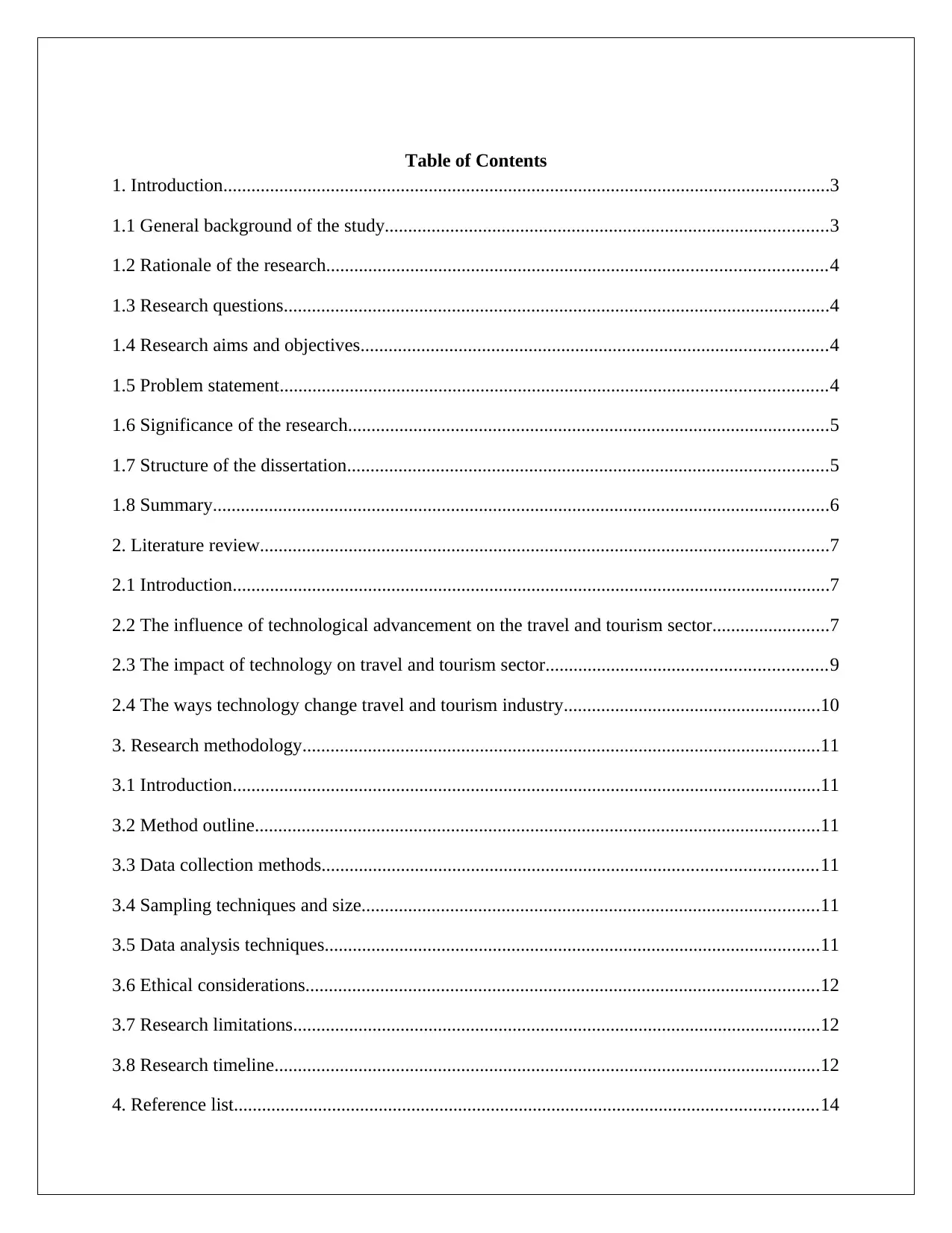
Table of Contents
1. Introduction..................................................................................................................................3
1.1 General background of the study...............................................................................................3
1.2 Rationale of the research...........................................................................................................4
1.3 Research questions.....................................................................................................................4
1.4 Research aims and objectives....................................................................................................4
1.5 Problem statement.....................................................................................................................4
1.6 Significance of the research.......................................................................................................5
1.7 Structure of the dissertation.......................................................................................................5
1.8 Summary....................................................................................................................................6
2. Literature review..........................................................................................................................7
2.1 Introduction................................................................................................................................7
2.2 The influence of technological advancement on the travel and tourism sector.........................7
2.3 The impact of technology on travel and tourism sector............................................................9
2.4 The ways technology change travel and tourism industry.......................................................10
3. Research methodology...............................................................................................................11
3.1 Introduction..............................................................................................................................11
3.2 Method outline.........................................................................................................................11
3.3 Data collection methods..........................................................................................................11
3.4 Sampling techniques and size..................................................................................................11
3.5 Data analysis techniques..........................................................................................................11
3.6 Ethical considerations..............................................................................................................12
3.7 Research limitations.................................................................................................................12
3.8 Research timeline.....................................................................................................................12
4. Reference list.............................................................................................................................14
1. Introduction..................................................................................................................................3
1.1 General background of the study...............................................................................................3
1.2 Rationale of the research...........................................................................................................4
1.3 Research questions.....................................................................................................................4
1.4 Research aims and objectives....................................................................................................4
1.5 Problem statement.....................................................................................................................4
1.6 Significance of the research.......................................................................................................5
1.7 Structure of the dissertation.......................................................................................................5
1.8 Summary....................................................................................................................................6
2. Literature review..........................................................................................................................7
2.1 Introduction................................................................................................................................7
2.2 The influence of technological advancement on the travel and tourism sector.........................7
2.3 The impact of technology on travel and tourism sector............................................................9
2.4 The ways technology change travel and tourism industry.......................................................10
3. Research methodology...............................................................................................................11
3.1 Introduction..............................................................................................................................11
3.2 Method outline.........................................................................................................................11
3.3 Data collection methods..........................................................................................................11
3.4 Sampling techniques and size..................................................................................................11
3.5 Data analysis techniques..........................................................................................................11
3.6 Ethical considerations..............................................................................................................12
3.7 Research limitations.................................................................................................................12
3.8 Research timeline.....................................................................................................................12
4. Reference list.............................................................................................................................14
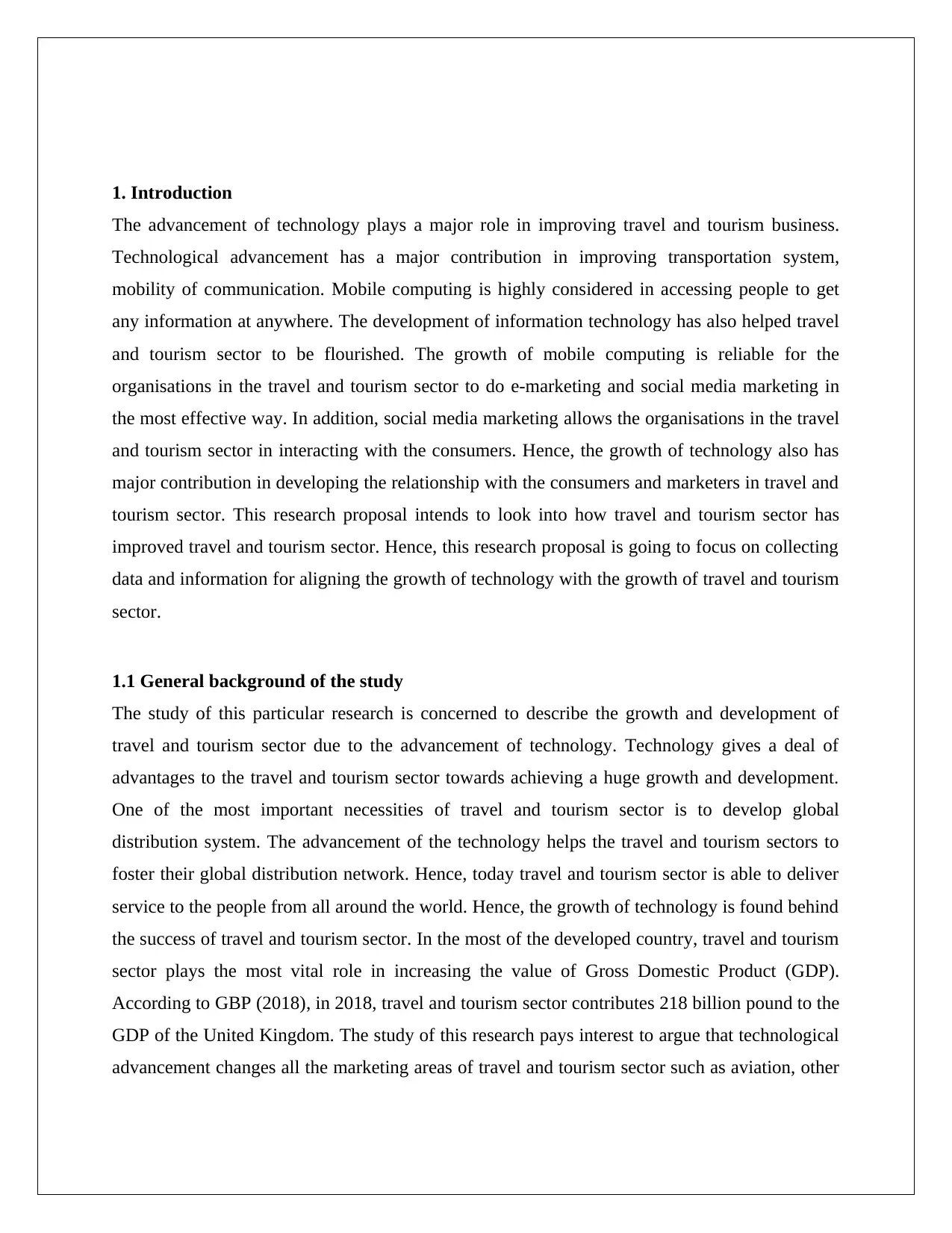
1. Introduction
The advancement of technology plays a major role in improving travel and tourism business.
Technological advancement has a major contribution in improving transportation system,
mobility of communication. Mobile computing is highly considered in accessing people to get
any information at anywhere. The development of information technology has also helped travel
and tourism sector to be flourished. The growth of mobile computing is reliable for the
organisations in the travel and tourism sector to do e-marketing and social media marketing in
the most effective way. In addition, social media marketing allows the organisations in the travel
and tourism sector in interacting with the consumers. Hence, the growth of technology also has
major contribution in developing the relationship with the consumers and marketers in travel and
tourism sector. This research proposal intends to look into how travel and tourism sector has
improved travel and tourism sector. Hence, this research proposal is going to focus on collecting
data and information for aligning the growth of technology with the growth of travel and tourism
sector.
1.1 General background of the study
The study of this particular research is concerned to describe the growth and development of
travel and tourism sector due to the advancement of technology. Technology gives a deal of
advantages to the travel and tourism sector towards achieving a huge growth and development.
One of the most important necessities of travel and tourism sector is to develop global
distribution system. The advancement of the technology helps the travel and tourism sectors to
foster their global distribution network. Hence, today travel and tourism sector is able to deliver
service to the people from all around the world. Hence, the growth of technology is found behind
the success of travel and tourism sector. In the most of the developed country, travel and tourism
sector plays the most vital role in increasing the value of Gross Domestic Product (GDP).
According to GBP (2018), in 2018, travel and tourism sector contributes 218 billion pound to the
GDP of the United Kingdom. The study of this research pays interest to argue that technological
advancement changes all the marketing areas of travel and tourism sector such as aviation, other
The advancement of technology plays a major role in improving travel and tourism business.
Technological advancement has a major contribution in improving transportation system,
mobility of communication. Mobile computing is highly considered in accessing people to get
any information at anywhere. The development of information technology has also helped travel
and tourism sector to be flourished. The growth of mobile computing is reliable for the
organisations in the travel and tourism sector to do e-marketing and social media marketing in
the most effective way. In addition, social media marketing allows the organisations in the travel
and tourism sector in interacting with the consumers. Hence, the growth of technology also has
major contribution in developing the relationship with the consumers and marketers in travel and
tourism sector. This research proposal intends to look into how travel and tourism sector has
improved travel and tourism sector. Hence, this research proposal is going to focus on collecting
data and information for aligning the growth of technology with the growth of travel and tourism
sector.
1.1 General background of the study
The study of this particular research is concerned to describe the growth and development of
travel and tourism sector due to the advancement of technology. Technology gives a deal of
advantages to the travel and tourism sector towards achieving a huge growth and development.
One of the most important necessities of travel and tourism sector is to develop global
distribution system. The advancement of the technology helps the travel and tourism sectors to
foster their global distribution network. Hence, today travel and tourism sector is able to deliver
service to the people from all around the world. Hence, the growth of technology is found behind
the success of travel and tourism sector. In the most of the developed country, travel and tourism
sector plays the most vital role in increasing the value of Gross Domestic Product (GDP).
According to GBP (2018), in 2018, travel and tourism sector contributes 218 billion pound to the
GDP of the United Kingdom. The study of this research pays interest to argue that technological
advancement changes all the marketing areas of travel and tourism sector such as aviation, other
⊘ This is a preview!⊘
Do you want full access?
Subscribe today to unlock all pages.

Trusted by 1+ million students worldwide

transportation, marketing and promotion of tourism, sanitation and security service, security and
communication of hotels and resorts, marketing communication etc.
1.2 Rationale of the research
For the last few decades, travel and tourism sector has improved a lot considering the
advancement of technology. Hence, in order to understand the growth and development of travel
and tourism sector, it will be highly reliable to study how technology advances travel and
tourism marketing. On the other hand, in order to understand marketing operations of travel and
tourism sector, the study of this research is considered reliable and reasonable (Xiang et al.,
2015).
1.3 Research questions
How are the growth and development of technology aligned with the growth and
development of travel and tourism sector?
What is the impact of technology on travel and tourism sector?
1.4 Research aims and objectives
The study of this research needs to aim in looking into the ways of technology, which are
regarded in terms of improving travel and tourism industry. In order to accomplish this aim, the
objectives of this research should be:
To evaluate the influences of technological advancement on travel and tourism sector
To explore the impacts of considering technology in travel and tourism sector
To explore in the ways technology helps the tourism marketing in developing their
operational skills
1.5 Problem statement
According to Standing et al. (2014), the consideration of technology is must to do business on
travel and tourism sector. The problem is that technological advancement is not only considered
for improving tourism marketing, but it is also considered to disrupt tourism marketing in many
communication of hotels and resorts, marketing communication etc.
1.2 Rationale of the research
For the last few decades, travel and tourism sector has improved a lot considering the
advancement of technology. Hence, in order to understand the growth and development of travel
and tourism sector, it will be highly reliable to study how technology advances travel and
tourism marketing. On the other hand, in order to understand marketing operations of travel and
tourism sector, the study of this research is considered reliable and reasonable (Xiang et al.,
2015).
1.3 Research questions
How are the growth and development of technology aligned with the growth and
development of travel and tourism sector?
What is the impact of technology on travel and tourism sector?
1.4 Research aims and objectives
The study of this research needs to aim in looking into the ways of technology, which are
regarded in terms of improving travel and tourism industry. In order to accomplish this aim, the
objectives of this research should be:
To evaluate the influences of technological advancement on travel and tourism sector
To explore the impacts of considering technology in travel and tourism sector
To explore in the ways technology helps the tourism marketing in developing their
operational skills
1.5 Problem statement
According to Standing et al. (2014), the consideration of technology is must to do business on
travel and tourism sector. The problem is that technological advancement is not only considered
for improving tourism marketing, but it is also considered to disrupt tourism marketing in many
Paraphrase This Document
Need a fresh take? Get an instant paraphrase of this document with our AI Paraphraser
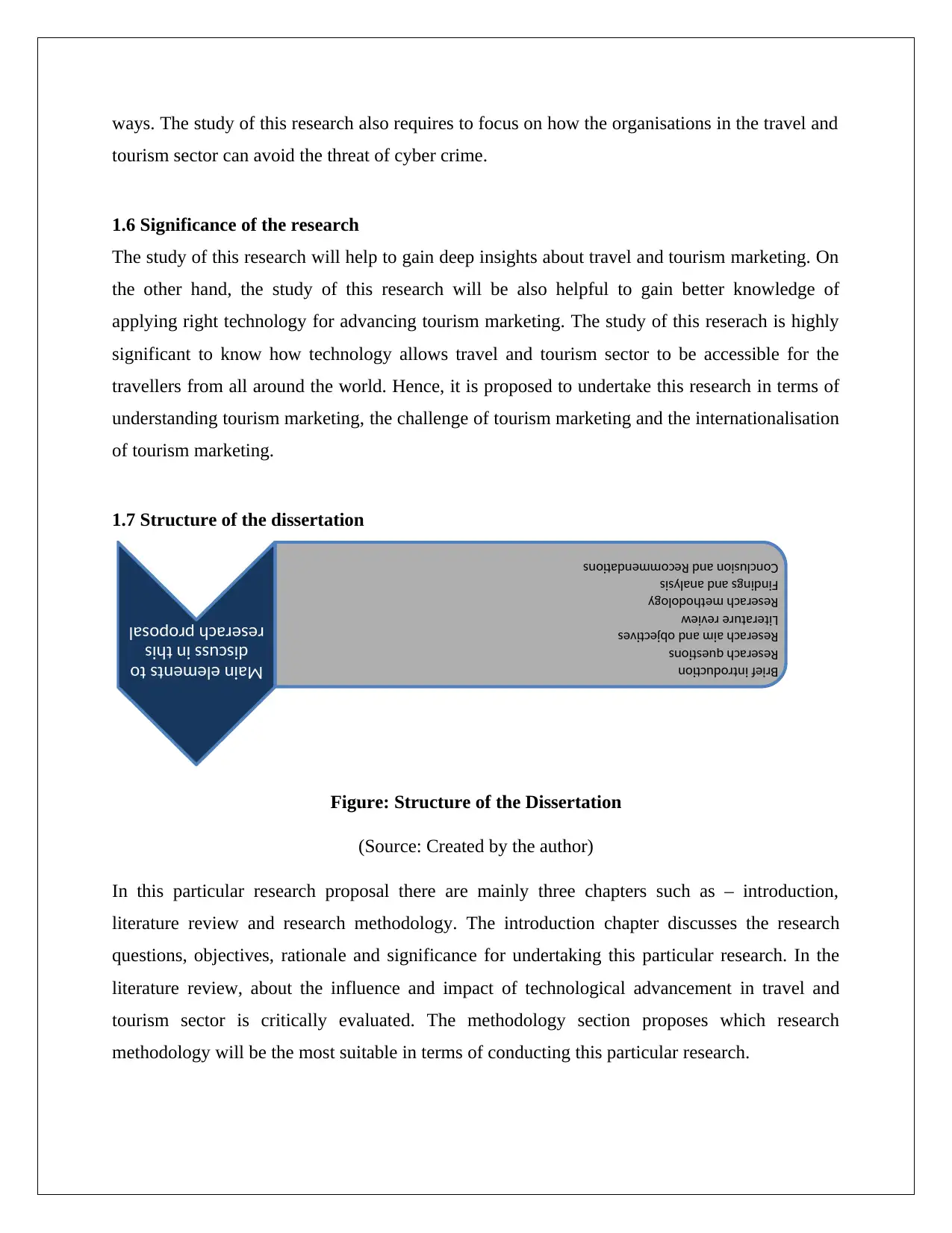
ways. The study of this research also requires to focus on how the organisations in the travel and
tourism sector can avoid the threat of cyber crime.
1.6 Significance of the research
The study of this research will help to gain deep insights about travel and tourism marketing. On
the other hand, the study of this research will be also helpful to gain better knowledge of
applying right technology for advancing tourism marketing. The study of this reserach is highly
significant to know how technology allows travel and tourism sector to be accessible for the
travellers from all around the world. Hence, it is proposed to undertake this research in terms of
understanding tourism marketing, the challenge of tourism marketing and the internationalisation
of tourism marketing.
1.7 Structure of the dissertation
Figure: Structure of the Dissertation
(Source: Created by the author)
In this particular research proposal there are mainly three chapters such as – introduction,
literature review and research methodology. The introduction chapter discusses the research
questions, objectives, rationale and significance for undertaking this particular research. In the
literature review, about the influence and impact of technological advancement in travel and
tourism sector is critically evaluated. The methodology section proposes which research
methodology will be the most suitable in terms of conducting this particular research.
Main elements to
discuss in this
reserach proposal
Brief introduction
Reserach questions
Reserach aim and objectives
Literature review
Reserach methodology
Findings and analysis
Conclusion and Recommendations
tourism sector can avoid the threat of cyber crime.
1.6 Significance of the research
The study of this research will help to gain deep insights about travel and tourism marketing. On
the other hand, the study of this research will be also helpful to gain better knowledge of
applying right technology for advancing tourism marketing. The study of this reserach is highly
significant to know how technology allows travel and tourism sector to be accessible for the
travellers from all around the world. Hence, it is proposed to undertake this research in terms of
understanding tourism marketing, the challenge of tourism marketing and the internationalisation
of tourism marketing.
1.7 Structure of the dissertation
Figure: Structure of the Dissertation
(Source: Created by the author)
In this particular research proposal there are mainly three chapters such as – introduction,
literature review and research methodology. The introduction chapter discusses the research
questions, objectives, rationale and significance for undertaking this particular research. In the
literature review, about the influence and impact of technological advancement in travel and
tourism sector is critically evaluated. The methodology section proposes which research
methodology will be the most suitable in terms of conducting this particular research.
Main elements to
discuss in this
reserach proposal
Brief introduction
Reserach questions
Reserach aim and objectives
Literature review
Reserach methodology
Findings and analysis
Conclusion and Recommendations
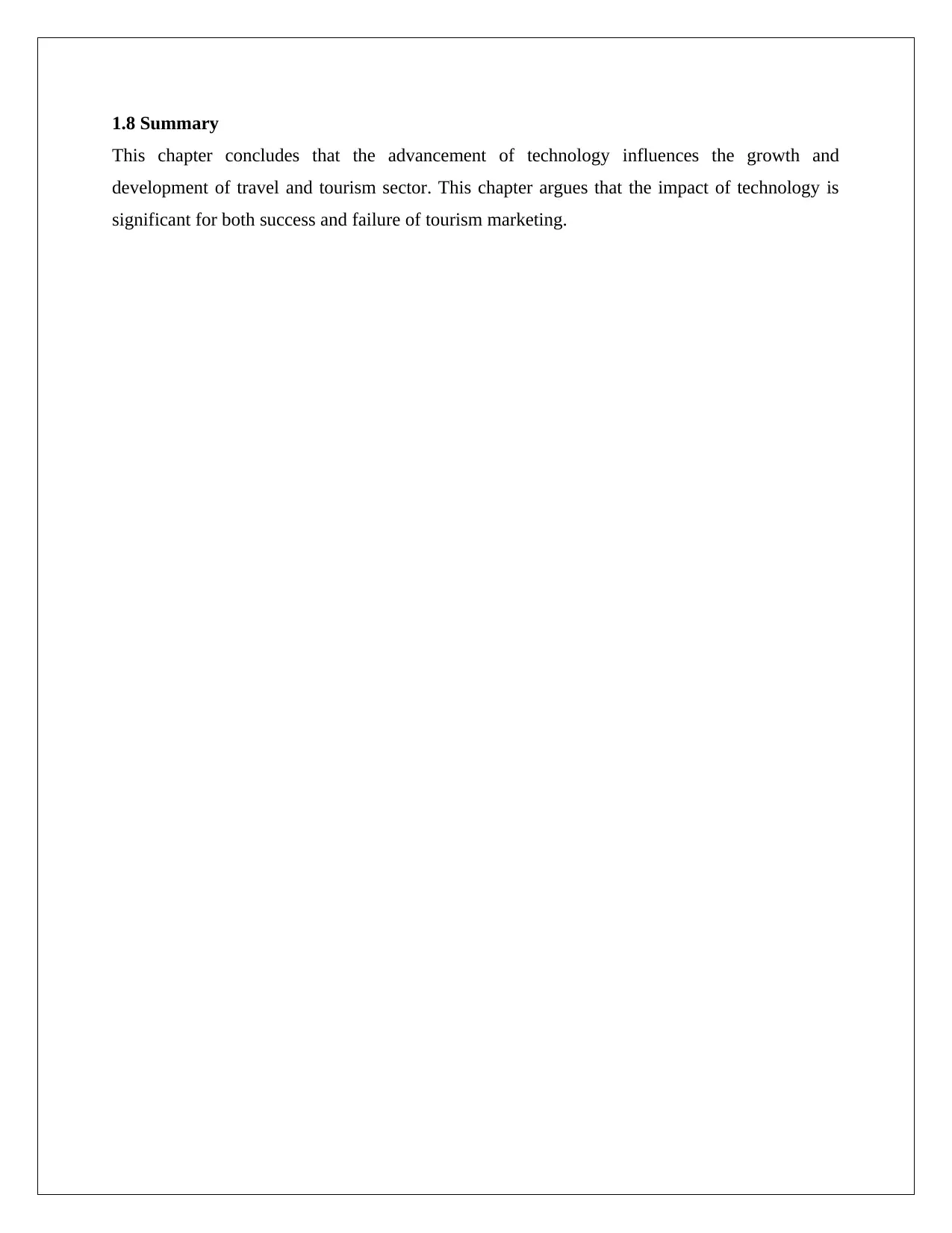
1.8 Summary
This chapter concludes that the advancement of technology influences the growth and
development of travel and tourism sector. This chapter argues that the impact of technology is
significant for both success and failure of tourism marketing.
This chapter concludes that the advancement of technology influences the growth and
development of travel and tourism sector. This chapter argues that the impact of technology is
significant for both success and failure of tourism marketing.
⊘ This is a preview!⊘
Do you want full access?
Subscribe today to unlock all pages.

Trusted by 1+ million students worldwide
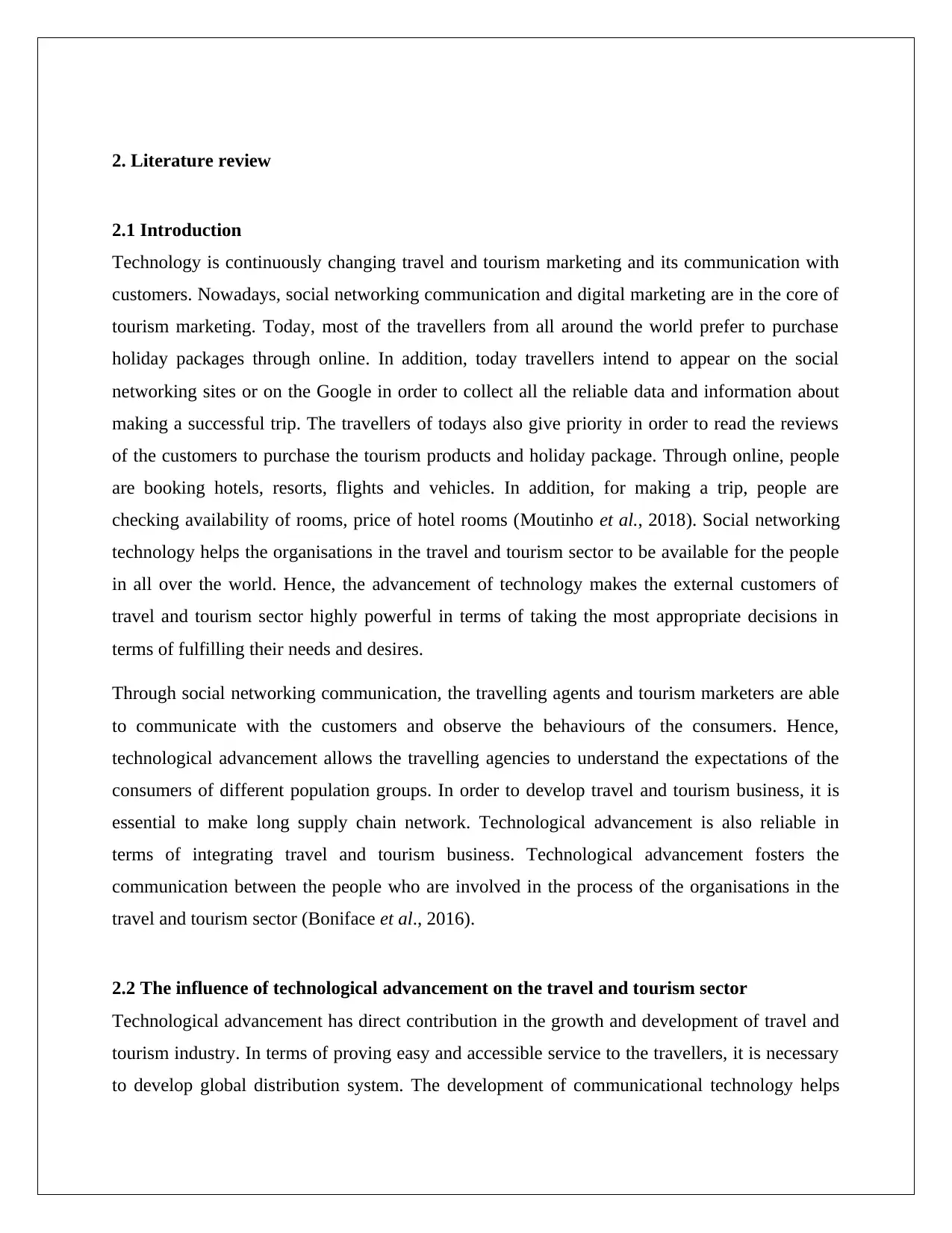
2. Literature review
2.1 Introduction
Technology is continuously changing travel and tourism marketing and its communication with
customers. Nowadays, social networking communication and digital marketing are in the core of
tourism marketing. Today, most of the travellers from all around the world prefer to purchase
holiday packages through online. In addition, today travellers intend to appear on the social
networking sites or on the Google in order to collect all the reliable data and information about
making a successful trip. The travellers of todays also give priority in order to read the reviews
of the customers to purchase the tourism products and holiday package. Through online, people
are booking hotels, resorts, flights and vehicles. In addition, for making a trip, people are
checking availability of rooms, price of hotel rooms (Moutinho et al., 2018). Social networking
technology helps the organisations in the travel and tourism sector to be available for the people
in all over the world. Hence, the advancement of technology makes the external customers of
travel and tourism sector highly powerful in terms of taking the most appropriate decisions in
terms of fulfilling their needs and desires.
Through social networking communication, the travelling agents and tourism marketers are able
to communicate with the customers and observe the behaviours of the consumers. Hence,
technological advancement allows the travelling agencies to understand the expectations of the
consumers of different population groups. In order to develop travel and tourism business, it is
essential to make long supply chain network. Technological advancement is also reliable in
terms of integrating travel and tourism business. Technological advancement fosters the
communication between the people who are involved in the process of the organisations in the
travel and tourism sector (Boniface et al., 2016).
2.2 The influence of technological advancement on the travel and tourism sector
Technological advancement has direct contribution in the growth and development of travel and
tourism industry. In terms of proving easy and accessible service to the travellers, it is necessary
to develop global distribution system. The development of communicational technology helps
2.1 Introduction
Technology is continuously changing travel and tourism marketing and its communication with
customers. Nowadays, social networking communication and digital marketing are in the core of
tourism marketing. Today, most of the travellers from all around the world prefer to purchase
holiday packages through online. In addition, today travellers intend to appear on the social
networking sites or on the Google in order to collect all the reliable data and information about
making a successful trip. The travellers of todays also give priority in order to read the reviews
of the customers to purchase the tourism products and holiday package. Through online, people
are booking hotels, resorts, flights and vehicles. In addition, for making a trip, people are
checking availability of rooms, price of hotel rooms (Moutinho et al., 2018). Social networking
technology helps the organisations in the travel and tourism sector to be available for the people
in all over the world. Hence, the advancement of technology makes the external customers of
travel and tourism sector highly powerful in terms of taking the most appropriate decisions in
terms of fulfilling their needs and desires.
Through social networking communication, the travelling agents and tourism marketers are able
to communicate with the customers and observe the behaviours of the consumers. Hence,
technological advancement allows the travelling agencies to understand the expectations of the
consumers of different population groups. In order to develop travel and tourism business, it is
essential to make long supply chain network. Technological advancement is also reliable in
terms of integrating travel and tourism business. Technological advancement fosters the
communication between the people who are involved in the process of the organisations in the
travel and tourism sector (Boniface et al., 2016).
2.2 The influence of technological advancement on the travel and tourism sector
Technological advancement has direct contribution in the growth and development of travel and
tourism industry. In terms of proving easy and accessible service to the travellers, it is necessary
to develop global distribution system. The development of communicational technology helps
Paraphrase This Document
Need a fresh take? Get an instant paraphrase of this document with our AI Paraphraser
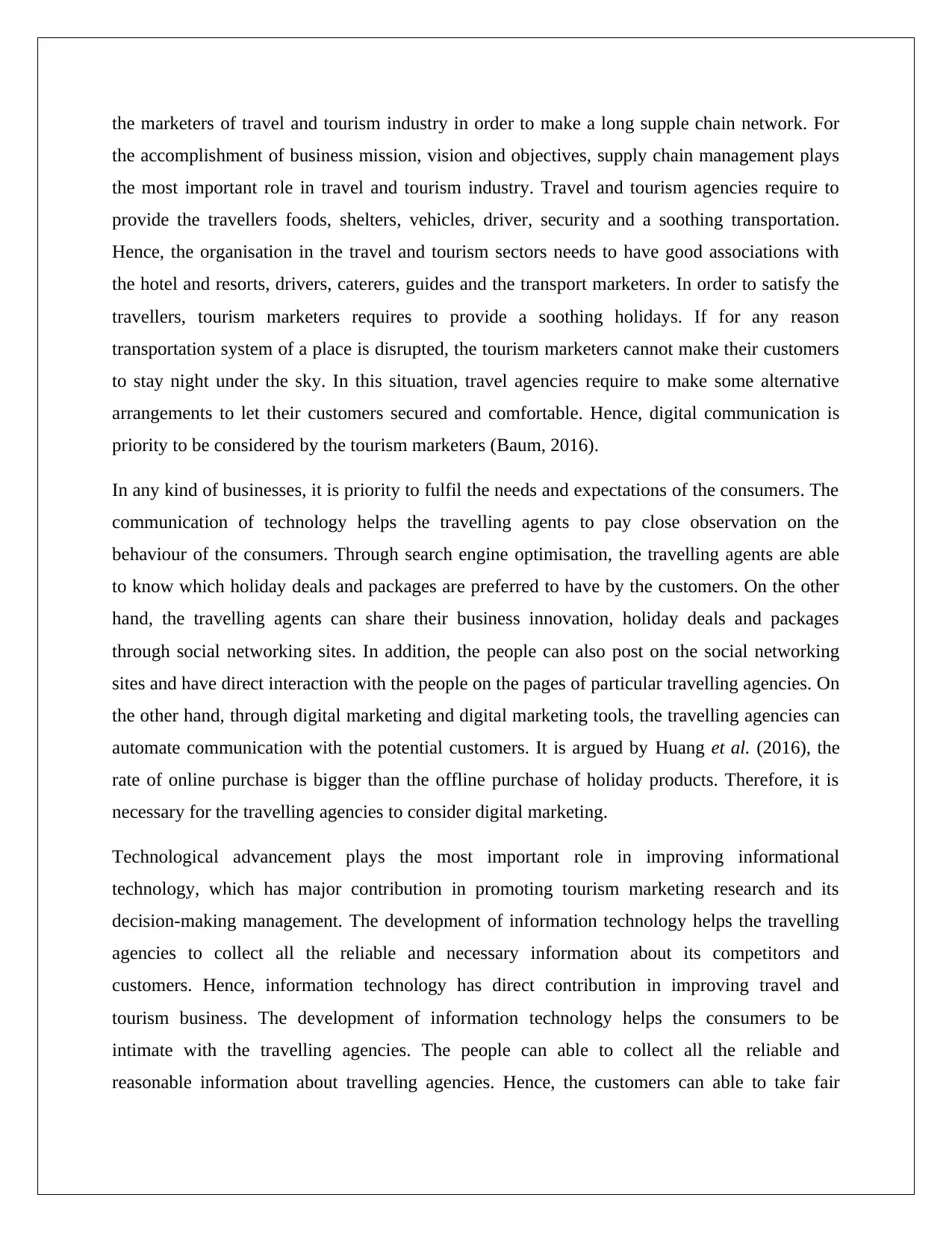
the marketers of travel and tourism industry in order to make a long supple chain network. For
the accomplishment of business mission, vision and objectives, supply chain management plays
the most important role in travel and tourism industry. Travel and tourism agencies require to
provide the travellers foods, shelters, vehicles, driver, security and a soothing transportation.
Hence, the organisation in the travel and tourism sectors needs to have good associations with
the hotel and resorts, drivers, caterers, guides and the transport marketers. In order to satisfy the
travellers, tourism marketers requires to provide a soothing holidays. If for any reason
transportation system of a place is disrupted, the tourism marketers cannot make their customers
to stay night under the sky. In this situation, travel agencies require to make some alternative
arrangements to let their customers secured and comfortable. Hence, digital communication is
priority to be considered by the tourism marketers (Baum, 2016).
In any kind of businesses, it is priority to fulfil the needs and expectations of the consumers. The
communication of technology helps the travelling agents to pay close observation on the
behaviour of the consumers. Through search engine optimisation, the travelling agents are able
to know which holiday deals and packages are preferred to have by the customers. On the other
hand, the travelling agents can share their business innovation, holiday deals and packages
through social networking sites. In addition, the people can also post on the social networking
sites and have direct interaction with the people on the pages of particular travelling agencies. On
the other hand, through digital marketing and digital marketing tools, the travelling agencies can
automate communication with the potential customers. It is argued by Huang et al. (2016), the
rate of online purchase is bigger than the offline purchase of holiday products. Therefore, it is
necessary for the travelling agencies to consider digital marketing.
Technological advancement plays the most important role in improving informational
technology, which has major contribution in promoting tourism marketing research and its
decision-making management. The development of information technology helps the travelling
agencies to collect all the reliable and necessary information about its competitors and
customers. Hence, information technology has direct contribution in improving travel and
tourism business. The development of information technology helps the consumers to be
intimate with the travelling agencies. The people can able to collect all the reliable and
reasonable information about travelling agencies. Hence, the customers can able to take fair
the accomplishment of business mission, vision and objectives, supply chain management plays
the most important role in travel and tourism industry. Travel and tourism agencies require to
provide the travellers foods, shelters, vehicles, driver, security and a soothing transportation.
Hence, the organisation in the travel and tourism sectors needs to have good associations with
the hotel and resorts, drivers, caterers, guides and the transport marketers. In order to satisfy the
travellers, tourism marketers requires to provide a soothing holidays. If for any reason
transportation system of a place is disrupted, the tourism marketers cannot make their customers
to stay night under the sky. In this situation, travel agencies require to make some alternative
arrangements to let their customers secured and comfortable. Hence, digital communication is
priority to be considered by the tourism marketers (Baum, 2016).
In any kind of businesses, it is priority to fulfil the needs and expectations of the consumers. The
communication of technology helps the travelling agents to pay close observation on the
behaviour of the consumers. Through search engine optimisation, the travelling agents are able
to know which holiday deals and packages are preferred to have by the customers. On the other
hand, the travelling agents can share their business innovation, holiday deals and packages
through social networking sites. In addition, the people can also post on the social networking
sites and have direct interaction with the people on the pages of particular travelling agencies. On
the other hand, through digital marketing and digital marketing tools, the travelling agencies can
automate communication with the potential customers. It is argued by Huang et al. (2016), the
rate of online purchase is bigger than the offline purchase of holiday products. Therefore, it is
necessary for the travelling agencies to consider digital marketing.
Technological advancement plays the most important role in improving informational
technology, which has major contribution in promoting tourism marketing research and its
decision-making management. The development of information technology helps the travelling
agencies to collect all the reliable and necessary information about its competitors and
customers. Hence, information technology has direct contribution in improving travel and
tourism business. The development of information technology helps the consumers to be
intimate with the travelling agencies. The people can able to collect all the reliable and
reasonable information about travelling agencies. Hence, the customers can able to take fair

decision in judging which travelling agencies are best in terms of accomplishment of their
holiday planning. Technology empowers customers to get right information and search holiday
products at their most afforded price. Hence, the travel and tourism industry is highly
competitive. In order to take market advantage, travelling agencies have to sale their products at
the most reasonable price and serve customers the best.
2.3 The impact of technology on travel and tourism sector
With the help of technology, now the tourists can be self sufficient in planning their holidays.
With the help of mobile technology, now the tourists can navigate ways around an unknown city.
On the other hand, now the tourists can book flight tickets, vehicles, hotel rooms self
sufficiently. It leaves a major impact on the sales of travel and tourism industry. Travelling
agencies require an effective marketing plan in terms of persuading customers to purchase their
holiday products. In addition, considering the power of the buyers, it has been argued by Schegg
and Stangl (2017) that the travel and tourism industry is highly competitive. For increasing sales
of holiday products, the travelling agencies require to make a good base of satisfied customers.
On the other hand, travelling agencies also have to face competition in terms of retaining old
customers.
Before purchasing holiday deals and booking a holiday from a travelling agency, people read
customers reviews. Hence, negative feedback discourages people to purchase holiday products
from a particular travelling agency. The new trend of digital marketing creates a force on the
marketers of travel and tourism sector in terms of accomplishing the needs and desires of the
travellers. On the other hand, considering the new trend of social media marketing, it is essential
for the marketers to collect customer feedback. The feedback of customers are considered the
best way to understand where an organisation cannot able to perform up to the mark in terms
keeping customers satisfied.
According to Rivera et al. (2015), considering the advance communication technology, travelling
agencies are able to integrate their marketing operations. Through social networking, sites the
travelling agencies can be the intimated with the customers and employees. On the other hand,
social networking platform offers the marketers of travel and tourism industry to conduct
effective marketing campaign. Considering the new social media marketing, for achieving
holiday planning. Technology empowers customers to get right information and search holiday
products at their most afforded price. Hence, the travel and tourism industry is highly
competitive. In order to take market advantage, travelling agencies have to sale their products at
the most reasonable price and serve customers the best.
2.3 The impact of technology on travel and tourism sector
With the help of technology, now the tourists can be self sufficient in planning their holidays.
With the help of mobile technology, now the tourists can navigate ways around an unknown city.
On the other hand, now the tourists can book flight tickets, vehicles, hotel rooms self
sufficiently. It leaves a major impact on the sales of travel and tourism industry. Travelling
agencies require an effective marketing plan in terms of persuading customers to purchase their
holiday products. In addition, considering the power of the buyers, it has been argued by Schegg
and Stangl (2017) that the travel and tourism industry is highly competitive. For increasing sales
of holiday products, the travelling agencies require to make a good base of satisfied customers.
On the other hand, travelling agencies also have to face competition in terms of retaining old
customers.
Before purchasing holiday deals and booking a holiday from a travelling agency, people read
customers reviews. Hence, negative feedback discourages people to purchase holiday products
from a particular travelling agency. The new trend of digital marketing creates a force on the
marketers of travel and tourism sector in terms of accomplishing the needs and desires of the
travellers. On the other hand, considering the new trend of social media marketing, it is essential
for the marketers to collect customer feedback. The feedback of customers are considered the
best way to understand where an organisation cannot able to perform up to the mark in terms
keeping customers satisfied.
According to Rivera et al. (2015), considering the advance communication technology, travelling
agencies are able to integrate their marketing operations. Through social networking, sites the
travelling agencies can be the intimated with the customers and employees. On the other hand,
social networking platform offers the marketers of travel and tourism industry to conduct
effective marketing campaign. Considering the new social media marketing, for achieving
⊘ This is a preview!⊘
Do you want full access?
Subscribe today to unlock all pages.

Trusted by 1+ million students worldwide
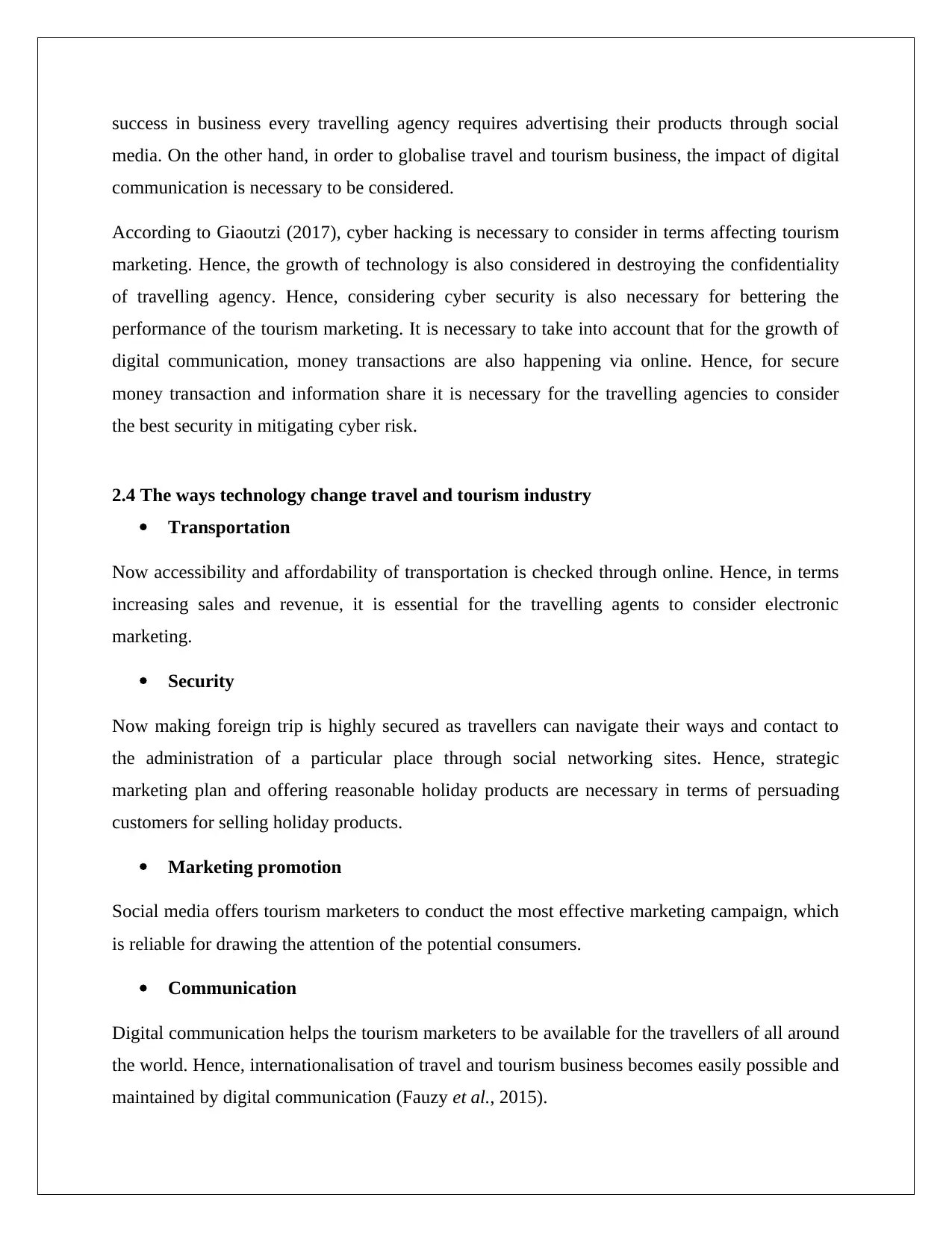
success in business every travelling agency requires advertising their products through social
media. On the other hand, in order to globalise travel and tourism business, the impact of digital
communication is necessary to be considered.
According to Giaoutzi (2017), cyber hacking is necessary to consider in terms affecting tourism
marketing. Hence, the growth of technology is also considered in destroying the confidentiality
of travelling agency. Hence, considering cyber security is also necessary for bettering the
performance of the tourism marketing. It is necessary to take into account that for the growth of
digital communication, money transactions are also happening via online. Hence, for secure
money transaction and information share it is necessary for the travelling agencies to consider
the best security in mitigating cyber risk.
2.4 The ways technology change travel and tourism industry
Transportation
Now accessibility and affordability of transportation is checked through online. Hence, in terms
increasing sales and revenue, it is essential for the travelling agents to consider electronic
marketing.
Security
Now making foreign trip is highly secured as travellers can navigate their ways and contact to
the administration of a particular place through social networking sites. Hence, strategic
marketing plan and offering reasonable holiday products are necessary in terms of persuading
customers for selling holiday products.
Marketing promotion
Social media offers tourism marketers to conduct the most effective marketing campaign, which
is reliable for drawing the attention of the potential consumers.
Communication
Digital communication helps the tourism marketers to be available for the travellers of all around
the world. Hence, internationalisation of travel and tourism business becomes easily possible and
maintained by digital communication (Fauzy et al., 2015).
media. On the other hand, in order to globalise travel and tourism business, the impact of digital
communication is necessary to be considered.
According to Giaoutzi (2017), cyber hacking is necessary to consider in terms affecting tourism
marketing. Hence, the growth of technology is also considered in destroying the confidentiality
of travelling agency. Hence, considering cyber security is also necessary for bettering the
performance of the tourism marketing. It is necessary to take into account that for the growth of
digital communication, money transactions are also happening via online. Hence, for secure
money transaction and information share it is necessary for the travelling agencies to consider
the best security in mitigating cyber risk.
2.4 The ways technology change travel and tourism industry
Transportation
Now accessibility and affordability of transportation is checked through online. Hence, in terms
increasing sales and revenue, it is essential for the travelling agents to consider electronic
marketing.
Security
Now making foreign trip is highly secured as travellers can navigate their ways and contact to
the administration of a particular place through social networking sites. Hence, strategic
marketing plan and offering reasonable holiday products are necessary in terms of persuading
customers for selling holiday products.
Marketing promotion
Social media offers tourism marketers to conduct the most effective marketing campaign, which
is reliable for drawing the attention of the potential consumers.
Communication
Digital communication helps the tourism marketers to be available for the travellers of all around
the world. Hence, internationalisation of travel and tourism business becomes easily possible and
maintained by digital communication (Fauzy et al., 2015).
Paraphrase This Document
Need a fresh take? Get an instant paraphrase of this document with our AI Paraphraser
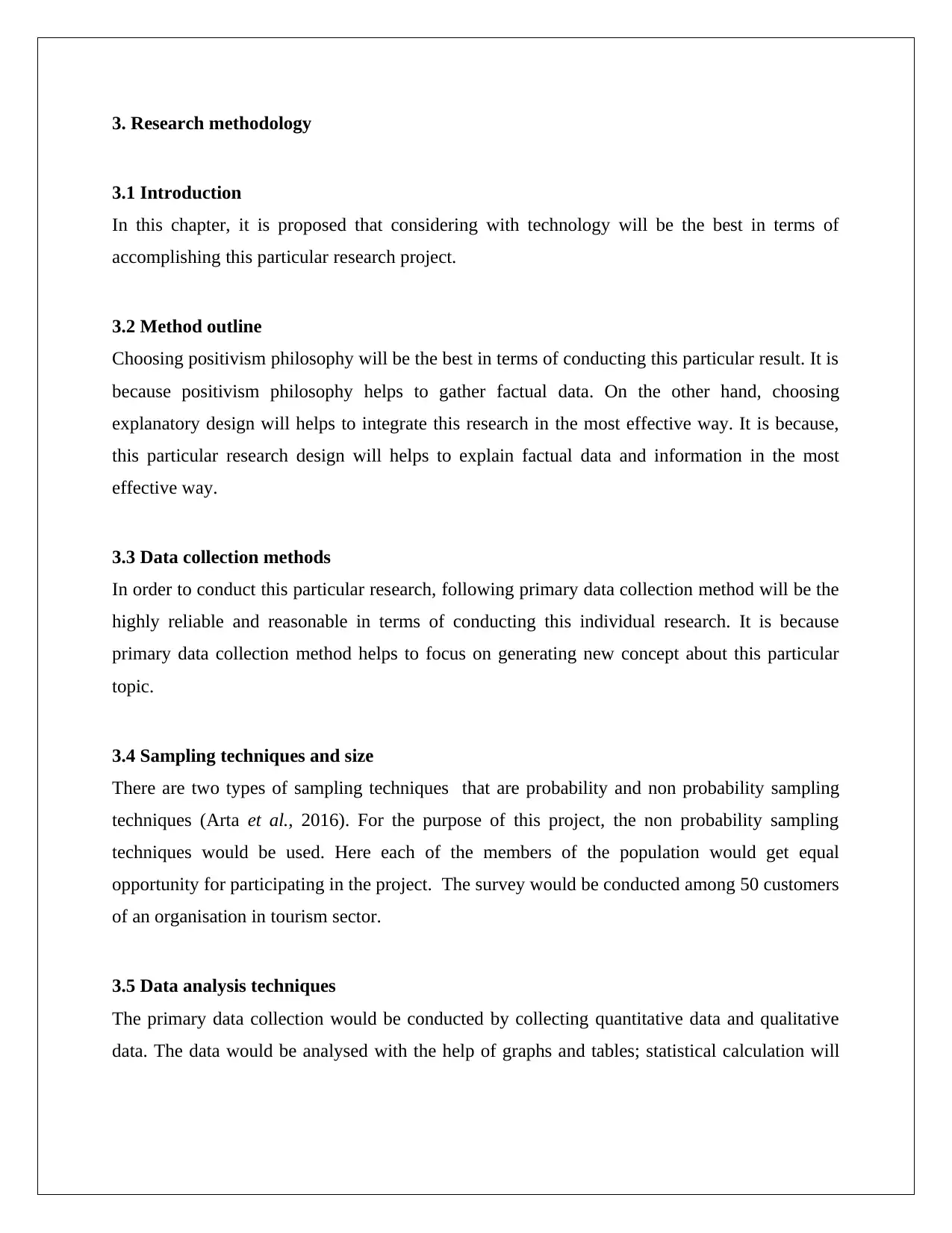
3. Research methodology
3.1 Introduction
In this chapter, it is proposed that considering with technology will be the best in terms of
accomplishing this particular research project.
3.2 Method outline
Choosing positivism philosophy will be the best in terms of conducting this particular result. It is
because positivism philosophy helps to gather factual data. On the other hand, choosing
explanatory design will helps to integrate this research in the most effective way. It is because,
this particular research design will helps to explain factual data and information in the most
effective way.
3.3 Data collection methods
In order to conduct this particular research, following primary data collection method will be the
highly reliable and reasonable in terms of conducting this individual research. It is because
primary data collection method helps to focus on generating new concept about this particular
topic.
3.4 Sampling techniques and size
There are two types of sampling techniques that are probability and non probability sampling
techniques (Arta et al., 2016). For the purpose of this project, the non probability sampling
techniques would be used. Here each of the members of the population would get equal
opportunity for participating in the project. The survey would be conducted among 50 customers
of an organisation in tourism sector.
3.5 Data analysis techniques
The primary data collection would be conducted by collecting quantitative data and qualitative
data. The data would be analysed with the help of graphs and tables; statistical calculation will
3.1 Introduction
In this chapter, it is proposed that considering with technology will be the best in terms of
accomplishing this particular research project.
3.2 Method outline
Choosing positivism philosophy will be the best in terms of conducting this particular result. It is
because positivism philosophy helps to gather factual data. On the other hand, choosing
explanatory design will helps to integrate this research in the most effective way. It is because,
this particular research design will helps to explain factual data and information in the most
effective way.
3.3 Data collection methods
In order to conduct this particular research, following primary data collection method will be the
highly reliable and reasonable in terms of conducting this individual research. It is because
primary data collection method helps to focus on generating new concept about this particular
topic.
3.4 Sampling techniques and size
There are two types of sampling techniques that are probability and non probability sampling
techniques (Arta et al., 2016). For the purpose of this project, the non probability sampling
techniques would be used. Here each of the members of the population would get equal
opportunity for participating in the project. The survey would be conducted among 50 customers
of an organisation in tourism sector.
3.5 Data analysis techniques
The primary data collection would be conducted by collecting quantitative data and qualitative
data. The data would be analysed with the help of graphs and tables; statistical calculation will
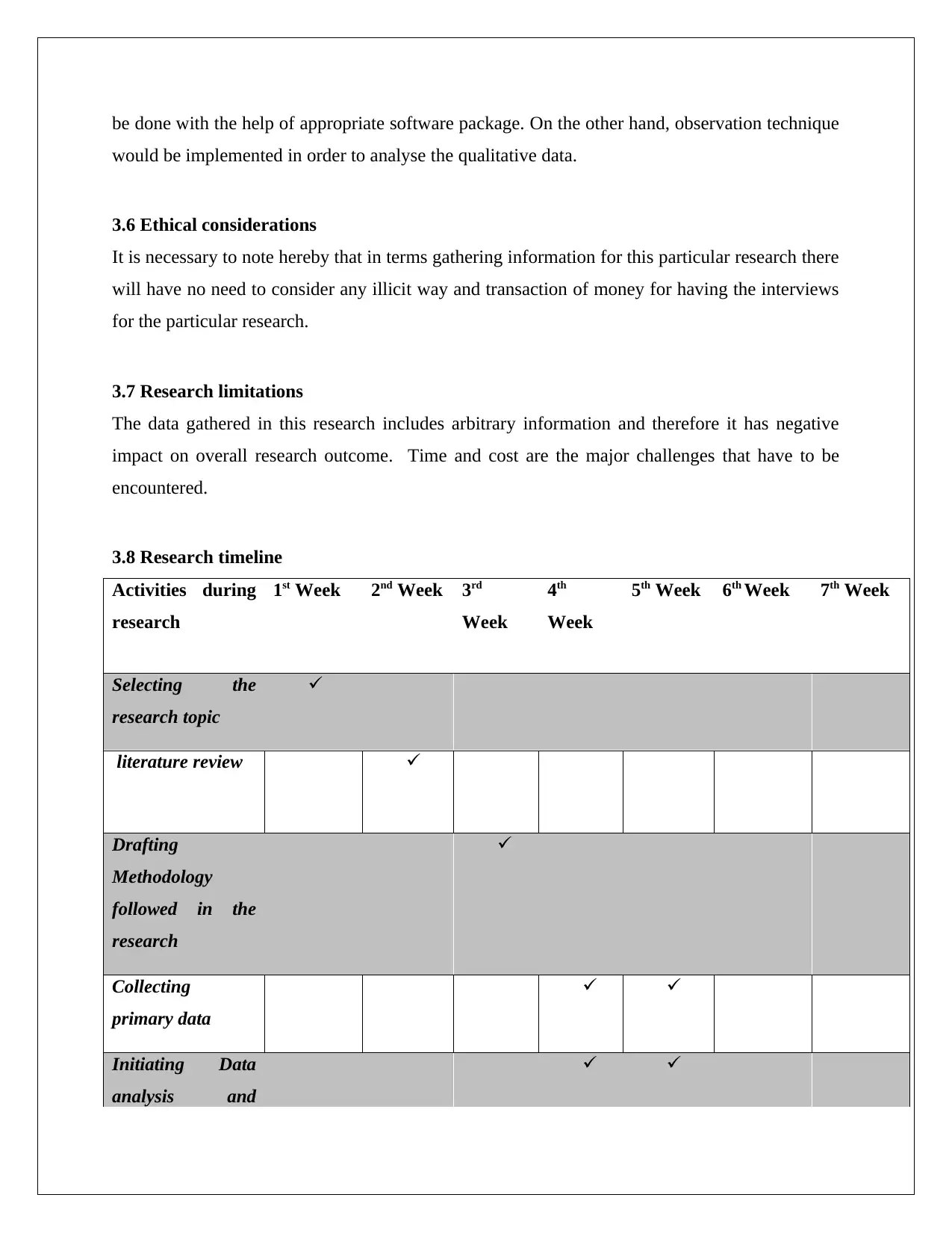
be done with the help of appropriate software package. On the other hand, observation technique
would be implemented in order to analyse the qualitative data.
3.6 Ethical considerations
It is necessary to note hereby that in terms gathering information for this particular research there
will have no need to consider any illicit way and transaction of money for having the interviews
for the particular research.
3.7 Research limitations
The data gathered in this research includes arbitrary information and therefore it has negative
impact on overall research outcome. Time and cost are the major challenges that have to be
encountered.
3.8 Research timeline
Activities during
research
1st Week 2nd Week 3rd
Week
4th
Week
5th Week 6th Week 7th Week
Selecting the
research topic
literature review
Drafting
Methodology
followed in the
research
Collecting
primary data
Initiating Data
analysis and
would be implemented in order to analyse the qualitative data.
3.6 Ethical considerations
It is necessary to note hereby that in terms gathering information for this particular research there
will have no need to consider any illicit way and transaction of money for having the interviews
for the particular research.
3.7 Research limitations
The data gathered in this research includes arbitrary information and therefore it has negative
impact on overall research outcome. Time and cost are the major challenges that have to be
encountered.
3.8 Research timeline
Activities during
research
1st Week 2nd Week 3rd
Week
4th
Week
5th Week 6th Week 7th Week
Selecting the
research topic
literature review
Drafting
Methodology
followed in the
research
Collecting
primary data
Initiating Data
analysis and
⊘ This is a preview!⊘
Do you want full access?
Subscribe today to unlock all pages.

Trusted by 1+ million students worldwide
1 out of 15
Related Documents
Your All-in-One AI-Powered Toolkit for Academic Success.
+13062052269
info@desklib.com
Available 24*7 on WhatsApp / Email
![[object Object]](/_next/static/media/star-bottom.7253800d.svg)
Unlock your academic potential
Copyright © 2020–2025 A2Z Services. All Rights Reserved. Developed and managed by ZUCOL.





